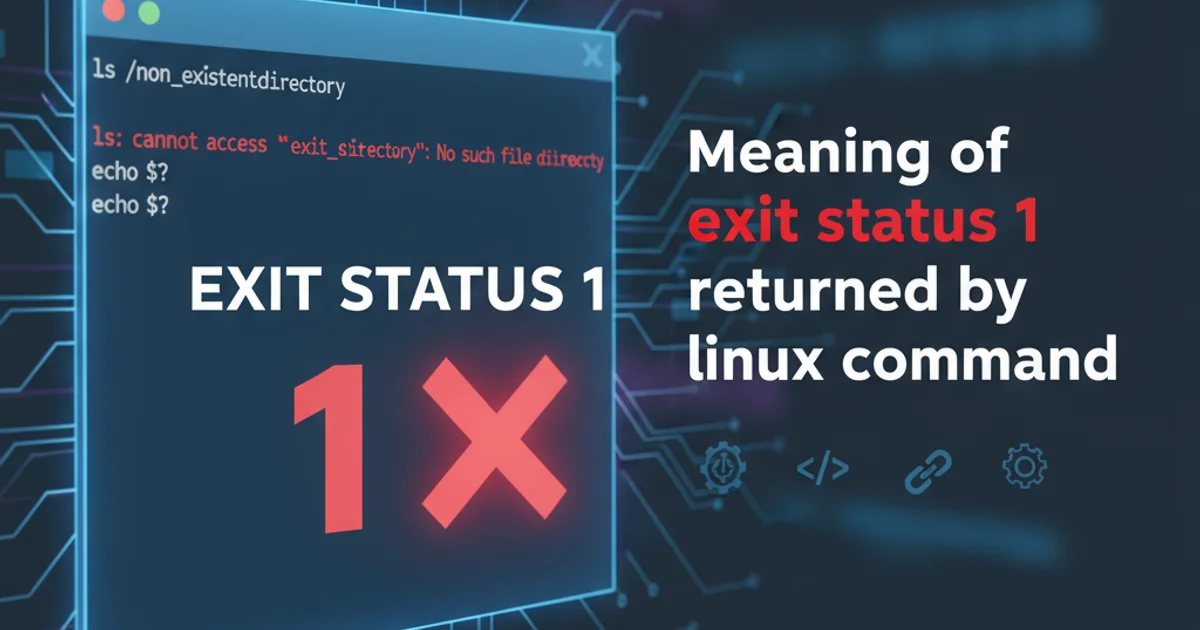Meaning of exit status 1 returned by linux command
Categories:
Understanding 'Exit Status 1' in Linux Commands

Demystify the meaning of exit status 1 in Linux, learn how to interpret it, and troubleshoot common command execution issues.
When you execute a command in Linux, it doesn't just perform an action; it also communicates the outcome of that action through an 'exit status' or 'exit code'. This numerical value is crucial for scripting, automation, and debugging. While an exit status of 0 typically signifies success, an exit status of 1 (or any non-zero value) indicates that something went wrong. This article will delve into the meaning of exit status 1, common scenarios where it occurs, and how to effectively diagnose and resolve issues.
What is an Exit Status?
Every command, script, or program executed in a Unix-like operating system returns an exit status upon completion. This integer value provides a simple way for the operating system and other programs to determine if the execution was successful or if an error occurred. The convention is as follows:
0: Success. The command completed its task without any issues.1: General error. This is a catch-all for various types of failures.2: Misuse of shell builtins (e.g., incorrect arguments).126: Command invoked cannot execute (e.g., permissions issue).127: Command not found.128+N: Fatal error signalN(e.g.,130forCtrl+Cwhich sendsSIGINT, whereN=2).
Understanding these codes is fundamental for robust shell scripting and effective troubleshooting.
flowchart TD
A[Execute Command] --> B{Command Completes?}
B -- Yes --> C{Exit Status == 0?}
C -- Yes --> D[Success]
C -- No --> E[Failure (Exit Status != 0)]
E --> F{Is Exit Status 1?}
F -- Yes --> G["General Error (e.g., file not found, permission denied)"]
F -- No --> H["Specific Error (e.g., 127: Command Not Found)"]Flowchart illustrating the interpretation of command exit statuses.
Common Causes of Exit Status 1
Exit status 1 is a generic error, meaning its specific cause can vary widely depending on the command and context. Here are some of the most frequent reasons you might encounter it:
- File Not Found or Invalid Path: The command attempts to access a file or directory that does not exist or is specified incorrectly.
- Permission Denied: The user executing the command lacks the necessary read, write, or execute permissions for a file or directory.
- Invalid Arguments or Options: The command was called with incorrect syntax, unknown options, or missing required arguments.
- Resource Exhaustion: The system ran out of memory, disk space, or other critical resources required by the command.
- Configuration Errors: A program or service fails to start or operate correctly due to a malformed configuration file.
- Logical Errors in Scripts: Within a shell script, an
exit 1statement might be explicitly used to signal a custom error condition. - External Program Failure: A command might call another program, and if that sub-program fails with a non-zero exit status, the parent command might also return 1.
# Example 1: File not found
ls non_existent_file
echo $?
# Example 2: Permission denied (try creating a file in /root as a normal user)
touch /root/test_file
echo $?
# Example 3: Invalid argument for 'grep'
grep --invalid-option "pattern" file.txt
echo $?
Demonstrating commands that typically result in exit status 1.
$? immediately after executing a command to retrieve its exit status. This is crucial for debugging and conditional execution in scripts.Diagnosing and Troubleshooting Exit Status 1
When faced with an exit status 1, follow these steps to diagnose the problem:
- Read the Error Message: Most commands will print an error message to
stderr(standard error) explaining why they failed. This is often the most direct clue. - Check Command Syntax: Consult the command's
manpage (man command_name) or help output (command_name --help) to ensure you are using the correct syntax and options. - Verify Paths and Permissions: Ensure that all files and directories referenced by the command exist and that the user has the necessary permissions to access them. Use
ls -lto check permissions andstatfor more detailed file information. - Examine Configuration Files: If the command is related to a service or application, check its configuration files for syntax errors or incorrect settings.
- Check System Resources: Monitor CPU, memory, and disk usage to rule out resource exhaustion as a cause.
- Run with Verbose Output: Many commands offer a verbose mode (e.g.,
-v,--verbose) that can provide more detailed information about what went wrong. - Isolate the Problem: If the command is part of a script, try running the problematic command in isolation to see if it still fails. Add
set -eto your script to make it exit immediately on the first failed command, which can help pinpoint the exact line causing the issue.
# Example of checking permissions
ls -l /etc/shadow
# Example of using verbose output (for 'cp' command)
cp -v /nonexistent/file /tmp/destination
# Example of a script using 'set -e'
#!/bin/bash
set -e
echo "Starting script..."
ls /nonexistent_directory # This will cause the script to exit immediately
echo "This line will not be reached if 'ls' fails."
Practical examples for diagnosing command failures.